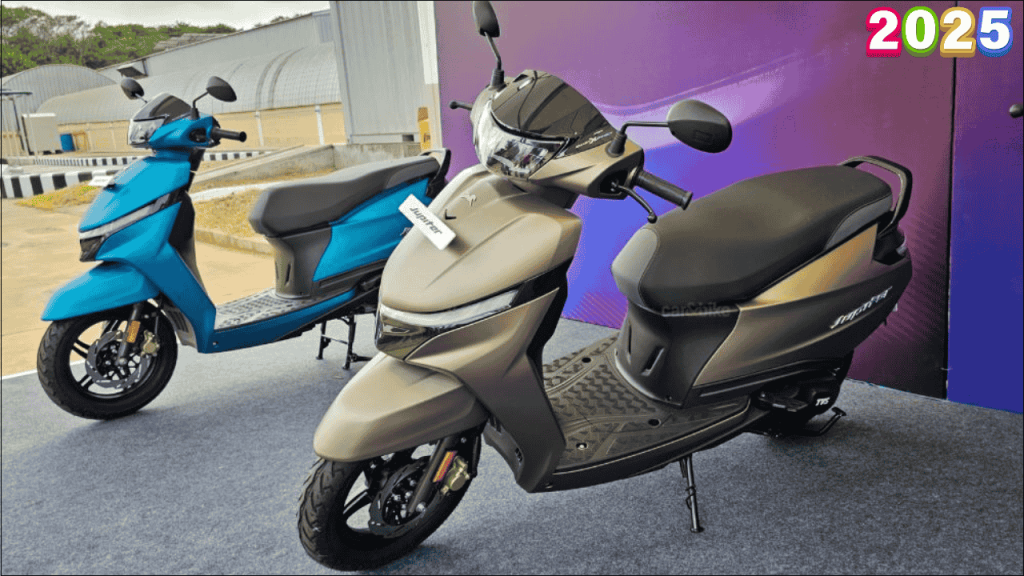
The Indian scooter market is buzzing with excitement as TVS Motor Company appears ready to introduce a game-changing hybrid variant of its popular Jupiter 125. This potential launch could revolutionize the 125cc scooter segment and set new benchmarks for fuel efficiency.
Following the remarkable success of the Jupiter lineup, TVS seems poised to enter the hybrid scooter space with a variant that promises to deliver exceptional mileage. If the rumors prove true, this could be the most fuel-efficient scooter in its class.
Spy Shots and Testing Phase
Recent reports from industry insiders suggest that TVS is actively testing a hybrid version of the Jupiter 125 near their Hosur manufacturing facility. While the company hasn’t made any official announcements, the timing aligns perfectly with growing consumer demand for eco-friendly two-wheelers.
Test mules spotted during trials reportedly feature several telltale signs of hybrid technology. These include a slightly bulkier engine casing, subtle design modifications, and what appears to be a battery housing unit positioned under the seat.
The hybrid system is expected to be a mild-hybrid setup, offering electric assistance during acceleration and incorporating idle start-stop technology. This configuration would be particularly beneficial in India’s stop-and-go traffic conditions.
Current Market Positioning
| Specification | TVS Jupiter 125 (Current) | Expected Hybrid Variant |
|---|---|---|
| Engine | 124.8cc Single Cylinder | 124.8cc + Electric Motor |
| Power Output | 8.15 bhp | 8.15+ bhp (Combined) |
| Current Mileage | 50-55 km/l | 60-65 km/l (Expected) |
| Price Range | ₹73,000-₹87,000 | ₹85,000-₹1,00,000 (Est.) |
| Fuel Tank | 6 Liters | 6 Liters |
| Weight | 108 kg | 115-120 kg (Est.) |
Why Hybrid Makes Perfect Sense
TVS has been strategically expanding its eco-friendly portfolio with the successful iQube electric scooter. However, many Indian consumers still have reservations about full electric vehicles due to range anxiety, charging infrastructure concerns, and higher costs.
A hybrid scooter serves as the perfect bridge between traditional petrol vehicles and full-electric models. This approach is particularly smart in India’s price-sensitive market where practicality often trumps cutting-edge technology.
With fluctuating petrol prices and increasingly congested urban traffic, consumers are actively seeking vehicles that offer superior fuel efficiency without compromising on performance or convenience.
Expected Features and Technology
The hybrid Jupiter 125 is likely to retain the proven 124.8cc single-cylinder engine from the current model, paired with a compact integrated electric motor. This combination should deliver enhanced performance characteristics and significantly improved fuel economy.
Key Expected Features:
- Regenerative braking system for energy recovery
- Automatic engine start-stop functionality
- Enhanced digital-analog instrument cluster
- Hybrid-specific information display
- Updated SmartXonnect connectivity features
- Retained external fuel fill convenience
- Spacious under-seat storage maintained
The electric motor assistance should provide smoother throttle response, especially during city riding conditions where frequent acceleration and deceleration are common.
Competitive Landscape Analysis
| Competitor | Engine | Mileage | Price Range | Unique Features |
|---|---|---|---|---|
| Honda Activa 125 | 124cc | 50-55 km/l | ₹74,000-₹87,000 | Market Leader |
| Suzuki Access 125 | 124cc | 50-55 km/l | ₹75,000-₹85,000 | Lightweight Design |
| TVS Jupiter 125 Hybrid | 124cc + Electric | 60-65 km/l (Est.) | ₹85,000-₹1,00,000 (Est.) | Hybrid Technology |
Market Impact and Competition Response
TVS’s entry into hybrid technology could trigger a significant shift in the 125cc scooter segment. This move might accelerate other manufacturers’ plans for hybrid or electric variants in this category.
Honda and Hero MotoCorp are already testing electric variants, but a hybrid Jupiter could disrupt market dynamics with its unique positioning. The hybrid approach offers familiarity with added technological benefits without requiring major lifestyle changes.
This strategy allows TVS to differentiate itself from competitors while addressing real consumer concerns about full electric adoption. The hybrid variant could attract both new buyers and existing customers seeking upgrades.
Expected Launch Timeline
Industry sources suggest the hybrid Jupiter 125 could debut by late 2025 or early 2026, potentially during India’s festive season when two-wheeler demand traditionally peaks.
The timing would be strategic, allowing TVS to capitalize on increased consumer spending and gifting trends during the festival period. This launch window also provides sufficient time for final testing and production preparation.
Technology Benefits Breakdown
Fuel Efficiency Gains:
- Electric motor assistance during acceleration
- Automatic engine shut-off at traffic lights
- Regenerative braking energy recovery
- Optimized engine operation
Urban Riding Advantages:
- Reduced emissions in city traffic
- Quieter operation during electric-only moments
- Smoother power delivery
- Lower running costs
Practical Benefits:
- No charging infrastructure dependency
- Familiar refueling process
- Extended range capability
- Lower maintenance complexity than full EVs
Future Implications
The potential launch of a TVS Jupiter 125 hybrid variant could mark the beginning of a new era in Indian urban mobility. By combining traditional petrol power with electric assistance, TVS might be pioneering a practical approach to sustainable transportation.
This hybrid technology could become the stepping stone for consumers transitioning from conventional vehicles to fully electric options. The success of this model could influence the entire two-wheeler industry’s approach to electrification.
Whether the hybrid Jupiter 125 truly delivers best-in-class mileage remains to be seen, but the concept alone has generated significant excitement in the market.
Market Expectations
Consumer expectations are high, particularly regarding fuel efficiency improvements and pricing. The success will largely depend on TVS’s ability to balance advanced technology with affordability.
The hybrid variant needs to offer substantial benefits over conventional models to justify any premium pricing. Early adopters will be looking for tangible improvements in daily commuting costs and environmental impact.
Frequently Asked Questions
When will the TVS Jupiter 125 hybrid variant launch? Expected launch is late 2025 or early 2026, possibly during the festive season.
What mileage can we expect from the hybrid version? Industry estimates suggest 60-65 km/l under city conditions, significantly higher than current variants.
Will the hybrid variant require special charging infrastructure? No, it’s expected to be a mild-hybrid system that doesn’t require external charging.
How much more expensive will the hybrid variant be? Estimated price premium of ₹10,000-₹15,000 over the standard Jupiter 125 variants.













